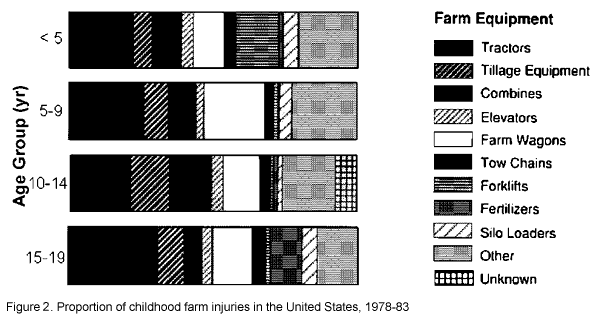 Studies have shown that at least 300 children die each year
because of injuries on the farm. An additional 23,500 children
are injured on the farm each year. Many of these injuries
are permanently disabling.
Studies have shown that at least 300 children die each year
because of injuries on the farm. An additional 23,500 children
are injured on the farm each year. Many of these injuries
are permanently disabling.
Research
has shown that children of all ages are involved in farm
accidents. Figure 1 shows the typical distribution of fatal
farm injuries by age. As children grow and develop, both
their play and work habits change. As a result, they are
more prone to certain types of accidents. (See Figure 2.)
Each age group is discussed in detail below.

TODDLERS AND PRESCHOOLERS (UNDER AGE 5)
Toddlers and preschoolers can climb, walk and run. This age group has a very short memory and likes to test reality. They learn by trial and error. Preschoolers have a fascination with moving parts, for example PTO'S, belts and moving corn in an auger.
Types of Injuries
Prevention
SCHOOL AGE CHILDREN (AGES 6-11)
Types of Injuries
Prevention
ADOLESCENT (AGES 12-16)
Age should not be used as the sole measure of maturity. Some other variables that distinguish individual adolescents are judgment and body size. Experience and observation help to improve judgment. A parent who takes proper safety precautions is the best teacher. Improper behaviors that parents perform automatically, for example stepping over a moving PTO, will likely be copied by a child. (For precautionary safety measures, see fact sheet AEX 991, Farm Safety for Children: What Parents and Grandparents Should Know.)
There is a tremendous difference in the size of adolescents. Growth occurs in spurts and varies between siblings. A task that was appropriate for one son or daughter at age 12, may not be appropriate for his/her brother or sister at the same age.
Types of Injuries
Prevention
Parents and grandparents should be sensitive to the development and needs of children. When assigning tasks to children, they need to consider a child's age, maturity level, attention span and physical size. If children are not physically ready for a task (for example, if they are too short), they should not be asked to perform the task. Do not alter machinery by using blocks on tractor brakes, for example.
Parents
and grandparents also need to assess the level of alertness
of children. If children have been in school all day, they
may be tired. Fatigue will increase the likelihood of an
accident. A little time spent evaluating children before
assigning tasks may end up saving their lives.
SOURCES
Publication #: AEX-991.1
This document is a series of the Agricultural Engineering Department and Department of Preventive Medicine, Ohio State University Extension, Columbus, Ohio 43210. Supported in part by project #MCH394001-02-1 from the Emergency Medical Services for Children program, Health Resources and Services Administration Department of Health and Human Services. Funded in whole or in part from Grant Number U05/CCU506070-02, "Cooperative Agreement Program for Agricultural Health Promotion Systems," National Institute for Occupational Safety and Health. Publication date: October 1992.
Thomas L. Bean, Safety Leader; Jennifer Wojtowicz, Graduate Assistant, Ohio State University Extension, Columbus, Ohio 43210. Reviewed by Dr. Randall Wood, Dr. Sue Nokes and Mr. Ron Clason, Department of Agricultural Engineering.
Disclaimer and Reproduction Information: Information in NASD does not represent NIOSH policy. Information included in NASD appears by permission of the author and/or copyright holder. More